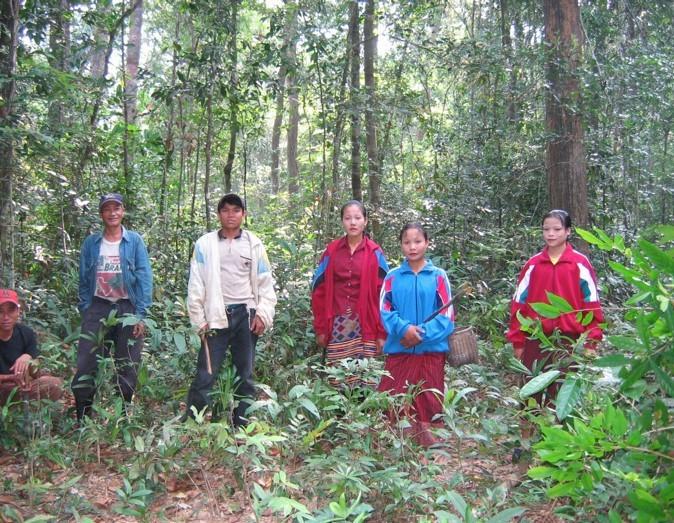
By Jeff Hayward and Benjamin Hodgdon
Strengthening forest communities is mission-critical to fighting climate change. To understand why, you must first understand that, if the goal of the Paris climate talks is to limit global warming to 2 degrees Celsius, negotiators cannot be content with just reducing emissions from fossil fuels. We must also reduce emissions from the land sector -- deforestation, agriculture and other land use.
Deforestation generates 10 to 11 percent of global greenhouse gas emissions. The entire land sector generates about a quarter of all GHGs, making it the second largest emitter after fossil fuels. But it’s the largest emitter in nearly 60 developing countries, and as the energy sector moves toward decarbonization, and deforestation pressures and food demand grow, the land sector’s share of global GHGs will grow, too.
It is urgent that we reverse this trajectory, starting with tropical forests, which sequester the most carbon but are under the most pressure from logging and clearing for agriculture. COP21 may produce an agreement on reducing emissions from deforestation and forest degradation (REDD+). But for REDD to work and save forests, we must help empower people and communities living in and around them to manage them sustainably.
If that sounds like a side note, think again. Forests where local communities and indigenous people have legal or official rights sequester 37.7 billion tons of carbon. That’s 29 times the annual CO2 emissions of all the passenger vehicles on the planet. Managing those forests sustainably will keep more of that carbon out of the atmosphere.
Today about a third of tropical forests are under some form of local community control, and that share is growing. Latin America, with its long tradition of land reform and local forest rights, is the trend’s epicenter. But it’s also taking hold in tropical regions of Africa and Asia as well.
Trying to save forests by handing them over to local communities might seem like a gamble. And it’s particularly hard to conceive if your model is the Western United States, where vast unpopulated areas were turned into strictly protected preserves by a distant, central government. But after decades of investing in that approach, it’s now clear that it hasn’t worked in the tropics, where forests are home to many people who depend on them for livelihoods.
There’s growing evidence that these people are the ones who can protect their forests best. Field research shows that local groups can conserve forests at least as well as government-run preserves, often better. To do this, they need clear authority to manage the land, harvest resources sustainably and sell them into good markets. Otherwise, deforestation risks can actually increase. But where those conditions are met, community forests dramatically outperform strict government-protected areas, or just about any other conservation approach.
For example, northern Guatemala has one of the highest rates of forest conversion in the Americas, mainly from illegal ranching. In the 5 million-acre Maya Biosphere Reserve, the largest protected area in Central America, about a third of the area is government preserves, which still experience considerable deforestation (1 percent a year). But other areas are community-managed forests certified by the Forest Stewardship Council for sustainable extraction of timber and other forest products. Studies show those areas have near-zero deforestation, conserving about a quarter of the Reserve’s forest cover while driving economic development.
That is not an isolated example. Deforestation rates in community forests in Mexico’s Yucatan Peninsula are also effectively zero. In Brazil, indigenous lands have less than a tenth of the deforestation of lands outside. In the Bolivian Amazon, they have a sixth of the deforestation of lands outside.
Such outcomes are remarkable. But to achieve them, community forests need to be be incentivized -- profitable enough to withstand economic pressures driving deforestation and allow communities to thrive while distributing economic and social benefits justly. In many places where local communities are gaining rights to their forests, that’s still a long way off.
Over the last 15 years, the Rainforest Alliance has worked with hundreds of community forests and local enterprises, to understand and help overcome the barriers they face. We’ve documented many cases where community-managed forests were both profitable and sustainable. We also found cases where large areas of forest were lost after communities obtained title to them, for example in the Peruvian Amazon, where forests titled to indigenous communities were subject to government concessions for mining and oil and gas extraction. They need help building capacity to defend their land rights, establish stronger governance and participate in land-use planning.
As the negotiations in Paris unfold, expect to hear a lot about halting deforestation and rural development in country-by-country emissions reduction plans, known as INDCs (Intended Nationally Determined Contributions). We probably won’t hear much about community forestry per se, though some INDCs refer to it, such as Brazil’s, which mentions “the role of indigenous lands in forest managed areas.” But to make REDD+ and INDCs more effective, countries should build community forest rights into their INDCs.
Forest communities seek economic development, and the financial resources and credit access that could come with REDD+ and national government programs may help. But what they need most of all is justice -- clear rights to their land and a supportive legal framework from governments so they can determine how their forests are managed and how benefits can be distributed equitably. Given those inputs, community forestry could be the single greatest untapped resource for closing the “emissions gap” between the agreements made in Paris and what’s required to hold global warming to 2 degrees Celsius.
Benjamin Hodgdon is Director of Forestry at the Rainforest Alliance.
Jeff Hayward, Rainforest Alliance, Vice President, Climate, is at the climate talks in Paris as part of the Rainforest Alliance COP21 delegation.
TriplePundit has published articles from over 1000 contributors. If you'd like to be a guest author, please get in touch!














